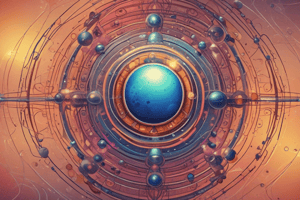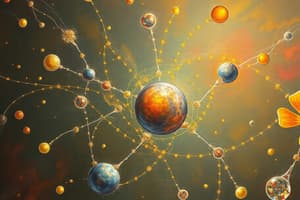Podcast
Questions and Answers
What is the correct electron configuration for the element Magnesium (Mg)?
What is the correct electron configuration for the element Magnesium (Mg)?
- 1s2 2s2 2p6 3s2 (correct)
- 1s2 2s2 3s2
- 1s2 2s2 2p6 3s1
- 1s2 2s2 2p6 4s2
Which element is represented by the electron configuration 1s2 2s2 2p6 3s2 3p64s23d104p3?
Which element is represented by the electron configuration 1s2 2s2 2p6 3s2 3p64s23d104p3?
- Arsenic (As) (correct)
- Selenium (Se)
- Germanium (Ge)
- Gallium (Ga)
In orbital notation, how many electrons can the 'd' subshell accommodate?
In orbital notation, how many electrons can the 'd' subshell accommodate?
- 14
- 10 (correct)
- 5
- 2
What configuration error occurs when two 'p' electrons share the same orbital while others remain empty?
What configuration error occurs when two 'p' electrons share the same orbital while others remain empty?
Which subshell must completely fill before any electrons occupy the 'p' subshell?
Which subshell must completely fill before any electrons occupy the 'p' subshell?
What determines the mass number of an atom?
What determines the mass number of an atom?
Which particle has a negative charge?
Which particle has a negative charge?
In an electrically neutral atom, how do the number of protons compare to the number of electrons?
In an electrically neutral atom, how do the number of protons compare to the number of electrons?
What makes an atom an ion?
What makes an atom an ion?
How do isotopes of the same element differ?
How do isotopes of the same element differ?
Which isotope of silicon has the greatest representation by percentage?
Which isotope of silicon has the greatest representation by percentage?
What is the charge of an atom with 8 protons and 10 electrons?
What is the charge of an atom with 8 protons and 10 electrons?
What is the average atomic mass of silicon given its isotopes' percentages?
What is the average atomic mass of silicon given its isotopes' percentages?
Which isotope of potassium is the most abundant?
Which isotope of potassium is the most abundant?
What happens to frequency when wavelength increases?
What happens to frequency when wavelength increases?
Which transition emits light with the highest frequency?
Which transition emits light with the highest frequency?
How many total electrons can be held by the 4p sublevel?
How many total electrons can be held by the 4p sublevel?
How does an electron move when it absorbs energy?
How does an electron move when it absorbs energy?
Which electron transition will absorb light with the highest energy?
Which electron transition will absorb light with the highest energy?
What is the maximum number of electrons in one orbital of the 5d sublevel?
What is the maximum number of electrons in one orbital of the 5d sublevel?
Which sublevels are available in the 3rd energy level?
Which sublevels are available in the 3rd energy level?
Flashcards
Proton
Proton
The positively charged particle found in the nucleus of an atom.
Neutron
Neutron
The neutrally charged particle found in the nucleus of an atom.
Electron
Electron
The negatively charged particle found orbiting the nucleus of an atom.
Mass Number
Mass Number
Signup and view all the flashcards
Charge
Charge
Signup and view all the flashcards
Atomic Number
Atomic Number
Signup and view all the flashcards
Isotopes
Isotopes
Signup and view all the flashcards
Ion
Ion
Signup and view all the flashcards
Electron Configuration and Chemical Properties
Electron Configuration and Chemical Properties
Signup and view all the flashcards
Periodic Table Blocks
Periodic Table Blocks
Signup and view all the flashcards
Orbital Notation
Orbital Notation
Signup and view all the flashcards
Hund's Rule
Hund's Rule
Signup and view all the flashcards
Aufbau Principle
Aufbau Principle
Signup and view all the flashcards
Abundant Isotopes and Average Atomic Mass
Abundant Isotopes and Average Atomic Mass
Signup and view all the flashcards
Wavelength and Frequency
Wavelength and Frequency
Signup and view all the flashcards
Energy and Frequency
Energy and Frequency
Signup and view all the flashcards
Electron Transition: Emission
Electron Transition: Emission
Signup and view all the flashcards
Electron Transition: Absorption
Electron Transition: Absorption
Signup and view all the flashcards
Highest Frequency Emission
Highest Frequency Emission
Signup and view all the flashcards
Highest Energy Absorption
Highest Energy Absorption
Signup and view all the flashcards
Electron Capacity of an Orbital
Electron Capacity of an Orbital
Signup and view all the flashcards
Study Notes
Atomic Structure Review
- Subatomic Particles:
- Protons: Small mass, positive charge, located in the nucleus.
- Neutrons: Small mass, neutral charge, located in the nucleus.
- Electrons: Small mass, negative charge, located in energy levels surrounding the nucleus.
Determining Atomic Properties
- Mass Number: Sum of protons and neutrons.
- Charge: Difference between the number of protons and electrons.
- Atomic Number: Number of protons in an atom.
Atomic Structure Sketch
- A sketch of an atom with 3 protons, 4 neutrons, and 2 electrons should be drawn, showing the nucleus with the protons and neutrons, and the electron cloud surrounding the nucleus.
Atomic Table Completion
- The table provides information about various elements including their symbol, atomic number, mass number, charge, proton count, neutron count, and electron count.
- Examples: Magnesium-24 has 12 protons, 12 neutrons, and 12 electrons .
- Oxygen-16 has 8 protons, 8 neutrons, and 8 electrons
Ions Identification
- Ions are atoms or molecules with a net electric charge.
- Elements in the table with a charge indicating a difference between protons and electrons are ions
- Examples: Oxygen (O-16) and Sodium (Na).
Isotopes
- Isotopes are atoms of the same element with different numbers of neutrons.
- They share the same number of protons but differ in mass number.
- Examples: Silicon-28, Silicon-29, and Silicon-30 are isotopes of silicon.
Average Atomic Mass Calculation
- The average atomic mass of an element is calculated by considering the abundance of each isotope.
- Examples: Determine the average atomic mass of silicon given the percentage amounts and mass of each isotope.
Determining the Most Abundant Isotope
- An element's most abundant isotope will be the isotope that contributes most to the element's average atomic mass. (based on percentage abundance.
Relationship Between Wavelength and Frequency
- Wavelength and frequency are inversely related.
- As one increases, the other decreases.
Relationship Between Energy and Frequency
- Energy and frequency are directly related.
- As one increases, the other increases.
Emission Spectra and Energy Levels
- Electrons absorb energy and move to higher energy levels.
- Electrons release energy and move to lower energy levels.
- This energy change is often emitted as light with specific wavelengths (colors).
Determining Electron Transitions
- Electron transitions between energy levels determine the energy and frequency of emitted light.
- Higher frequency transitions involve higher energy differences.
Electron Configuration
- Electron configurations describe how electrons are arranged in atoms. Sublevels within energy levels.
- Sublevels (s,p,d,f) have orbitals that relate to electron numbers and the order filling.
- Rules apply (e.g. Aufbau principle, Hund's rule)
Orbital Notation
- Orbital notations visualize electron distribution in atomic orbitals.
Studying That Suits You
Use AI to generate personalized quizzes and flashcards to suit your learning preferences.




